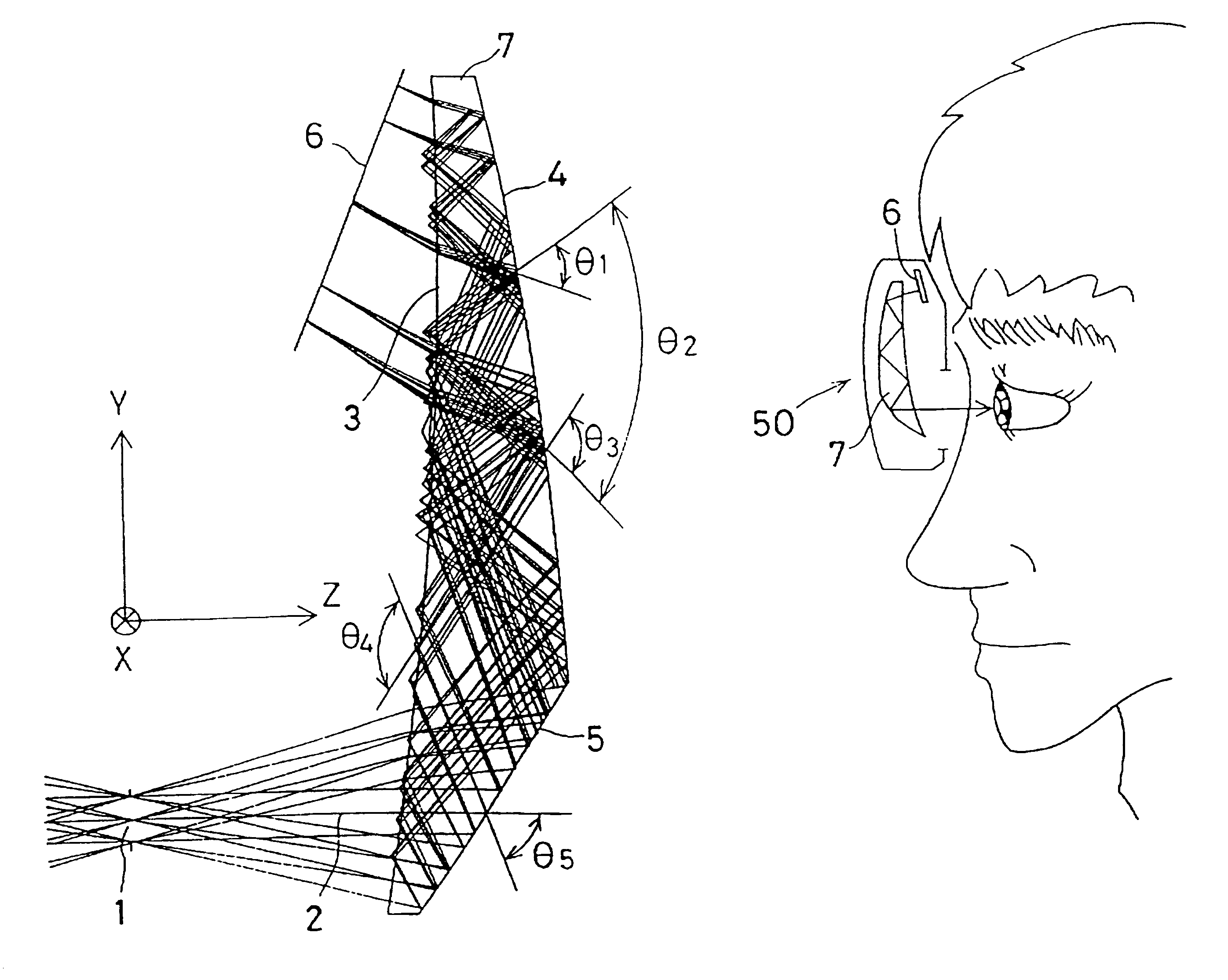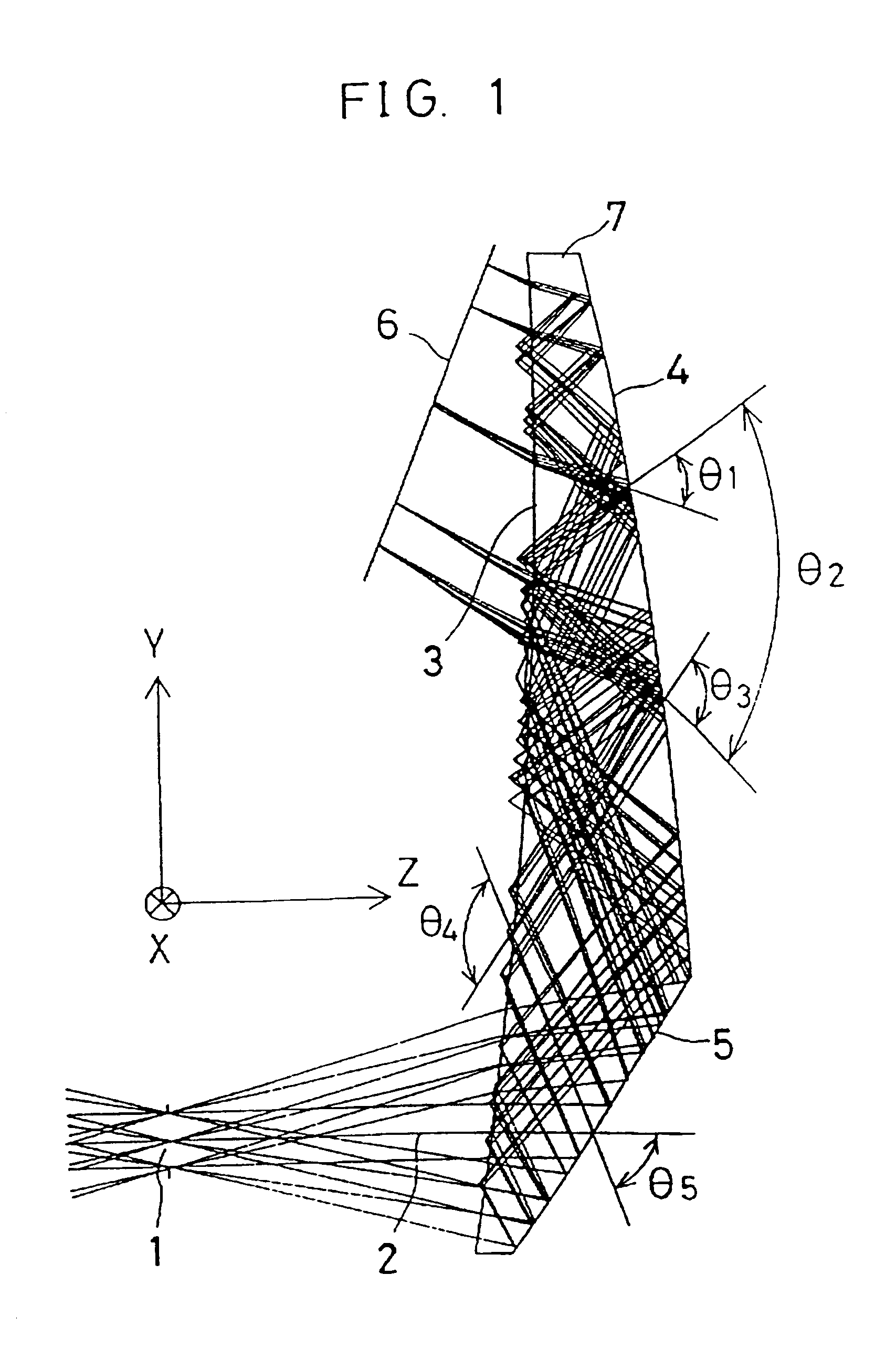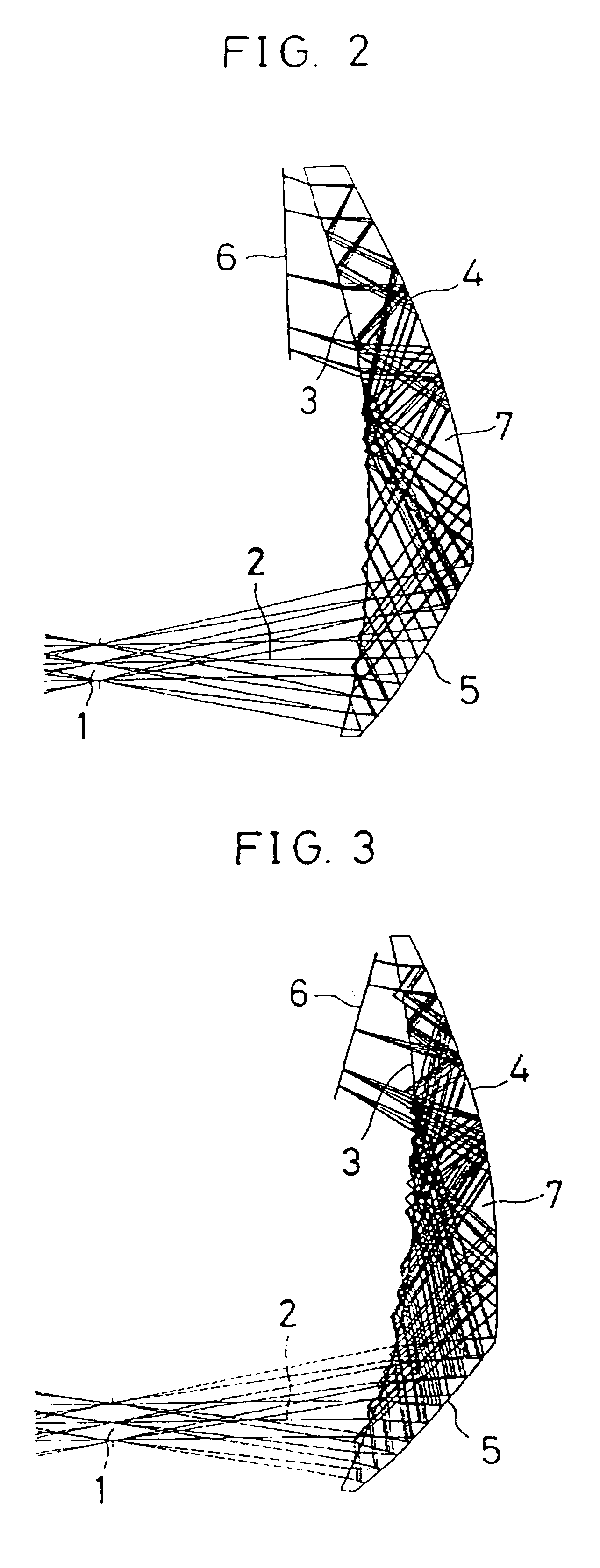Ocular optics system having at least four reflections occurring between curved surfaces
- Summary
- Abstract
- Description
- Claims
- Application Information
AI Technical Summary
Benefits of technology
Problems solved by technology
Method used
Image
Examples
examples 1 to 3
of the image display device constructed using the ocular optics system according to the present invention will now be explained with reference to the accompanying drawings.
Constitutional parameters of each example will now be given later. In what follows, surface numbers are given by back-tracing surfaces numbers as counted from an observer's pupil position 1 toward an image display element 6. As shown in FIG. 1, a coordinate system is composed of the origin defined by an observer's iris position 1, a Z axis defined by an observer's visual axis 2, whose direction from the origin toward an ocular optical system 7 is taken as being positive, a Y axis perpendicular to the observer's visual axis 2, whose direction from below to above with respect to an observer's eyeball is taken as being positive, and an X axis perpendicular to the observer's visual axis 2, whose direction from right to left with respect to the observer's eyeball is taken as being positive. In other words, a Y-Z plane ...
example 1
Sur- face Sur- sep- Refractive face Radius of ar- index Abbe's No. No. curvature ation (Displacement) (Tilt angle) 1 .infin. (pupil) 2 R.sub.y -427.518 1.51633 64.1 R.sub.x -29.212 Y 17.473 .theta. -5.351.degree. K.sub.y 0 Z 26.387 K.sub.x 0 AR 0 BR 0 AP 0 BP 0 3 R.sub.y -254.887 1.51633 64.1 R.sub.x -649.767 Y 130.176 .theta. 12.443.degree. K.sub.y 0 Z 52.819 K.sub.x 0 AR -0.876797 .times. 10.sup.-6 BR 0 AP -0.713380 BP 0 4 R.sub.y -427.518 1.51633 64.1 R.sub.x -29.212 Y 17.473 .theta. -5.351.degree. K.sub.y 0 Z 26.387 K.sub.x 0 AR 0 BR 0 AP 0 BP 0 5 R.sub.y -242.504 1.51633 64.1 R.sub.x -42.527 Y -31.772 .theta. -8.869.degree. K.sub.y 0 Z 36.510 K.sub.x 0 AR 0 BR 0 AP 0 BP 0 6 R.sub.y -427.518 1.51633 64.1 R.sub.x -29.212 Y 17.473 .theta. -5.351.degree. K.sub.y 0 Z 26.387 K.sub.x 0 AR 0 BR 0 AP 0 BP 0 7 R.sub.y -242.504 1.51633 64.1 R.sub.x -42.527 Y -31.772 .theta. -8.869.degree. K.sub.y 0 Z 36.510 K.sub.x 0 AR 0 BR 0 AP 0 BP 0 8 R.sub.y -427.518 Y 17.473 .theta. -5.351.degree. R...
example 2
Sur- face Refractive Sur- sep- index face Radius of ar- (Displace- Abbe's No. No. curvature ation ment) (Tilt angle) 1 .infin. (pupil) 2 R.sub.y -152.846 1.51633 64.1 R.sub.x -66.891 Y -13.768 .theta. -13.449.degree. K.sub.y 0 Z 27.500 K.sub.x 0 AR -0.178178 .times. 10.sup.-8 BR -0.594362 .times. 10.sup.-11 AP 0.105146 .times. 10 BP 0.664504 3 R.sub.y -119.363 1.51633 64.1 R.sub.x -82.534 Y 47.793 .theta. 6.177.degree. K.sub.y 0 Z 54.768 K.sub.x 0 AR -0.190871 .times. 10.sup.-6 BR 0.305496 .times. 10.sup.-11 AP 0.660695 .times. 10.sup.-1 BP 0.487236 4 R.sub.y -152.846 1.51633 64.1 R.sub.x -66.891 Y -13.768 .theta. -13.419.degree. K.sub.y 0 Z 27.500 K.sub.x 0 AR -0.178178 .times. 10.sup.-8 BR -0.594362 .times. 10.sup.-11 AP 0.105146 .times. 10 BP 0.664504 5 R.sub.y -118.626 1.51633 64.1 R.sub.x -82.339 Y -26.271 .theta. -14.237.degree. K.sub.y 0 Z 40.718 K.sub.x 0 AR -0.122336 .times. 10.sup.-7 BR -0.514035 .times. 10.sup.-12 AP -0.236341 .times. 10 BP 0.831265 6 R.sub.y -152.846 1.5...
PUM
 Login to View More
Login to View More Abstract
Description
Claims
Application Information
 Login to View More
Login to View More - R&D
- Intellectual Property
- Life Sciences
- Materials
- Tech Scout
- Unparalleled Data Quality
- Higher Quality Content
- 60% Fewer Hallucinations
Browse by: Latest US Patents, China's latest patents, Technical Efficacy Thesaurus, Application Domain, Technology Topic, Popular Technical Reports.
© 2025 PatSnap. All rights reserved.Legal|Privacy policy|Modern Slavery Act Transparency Statement|Sitemap|About US| Contact US: help@patsnap.com



